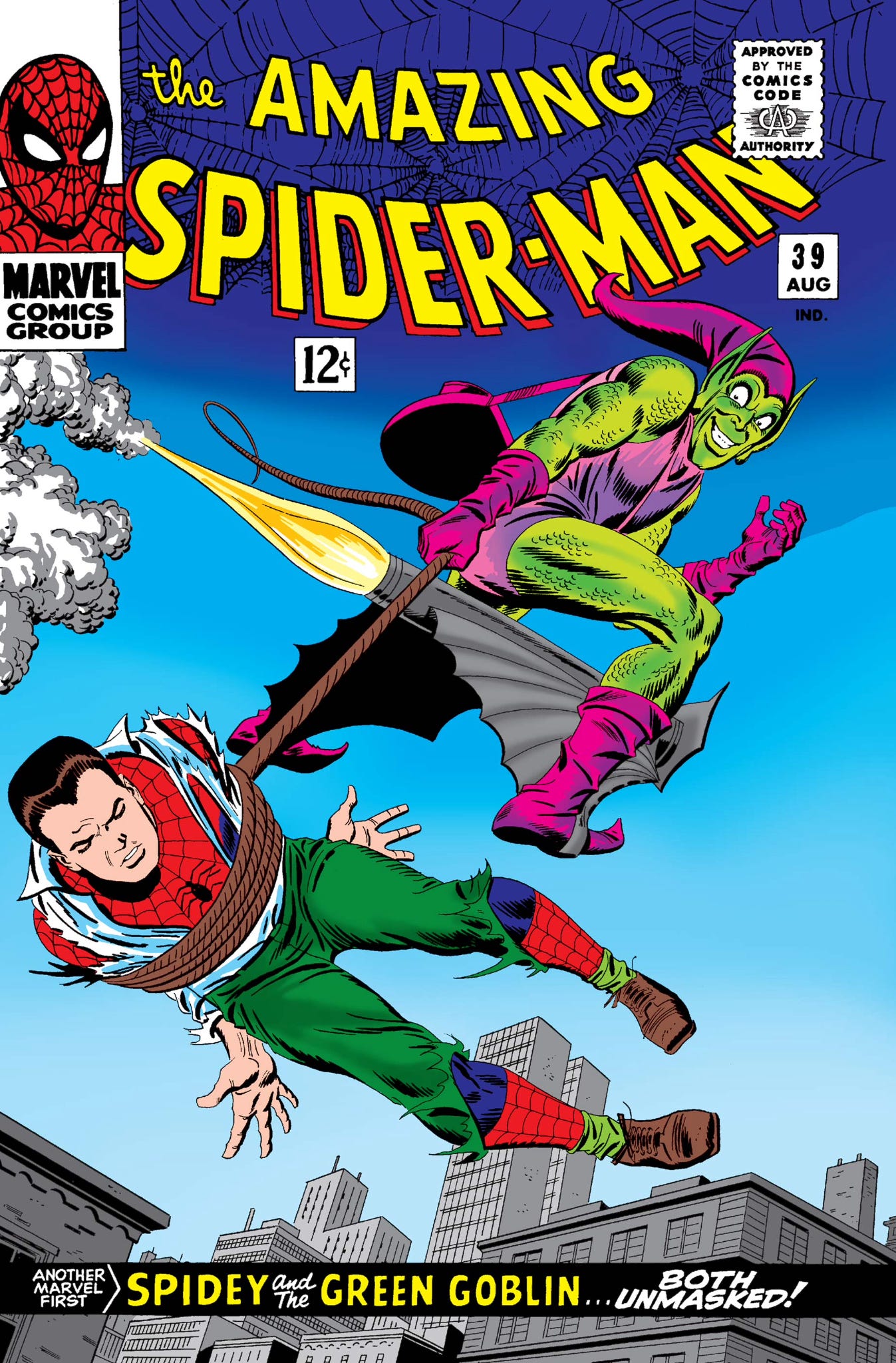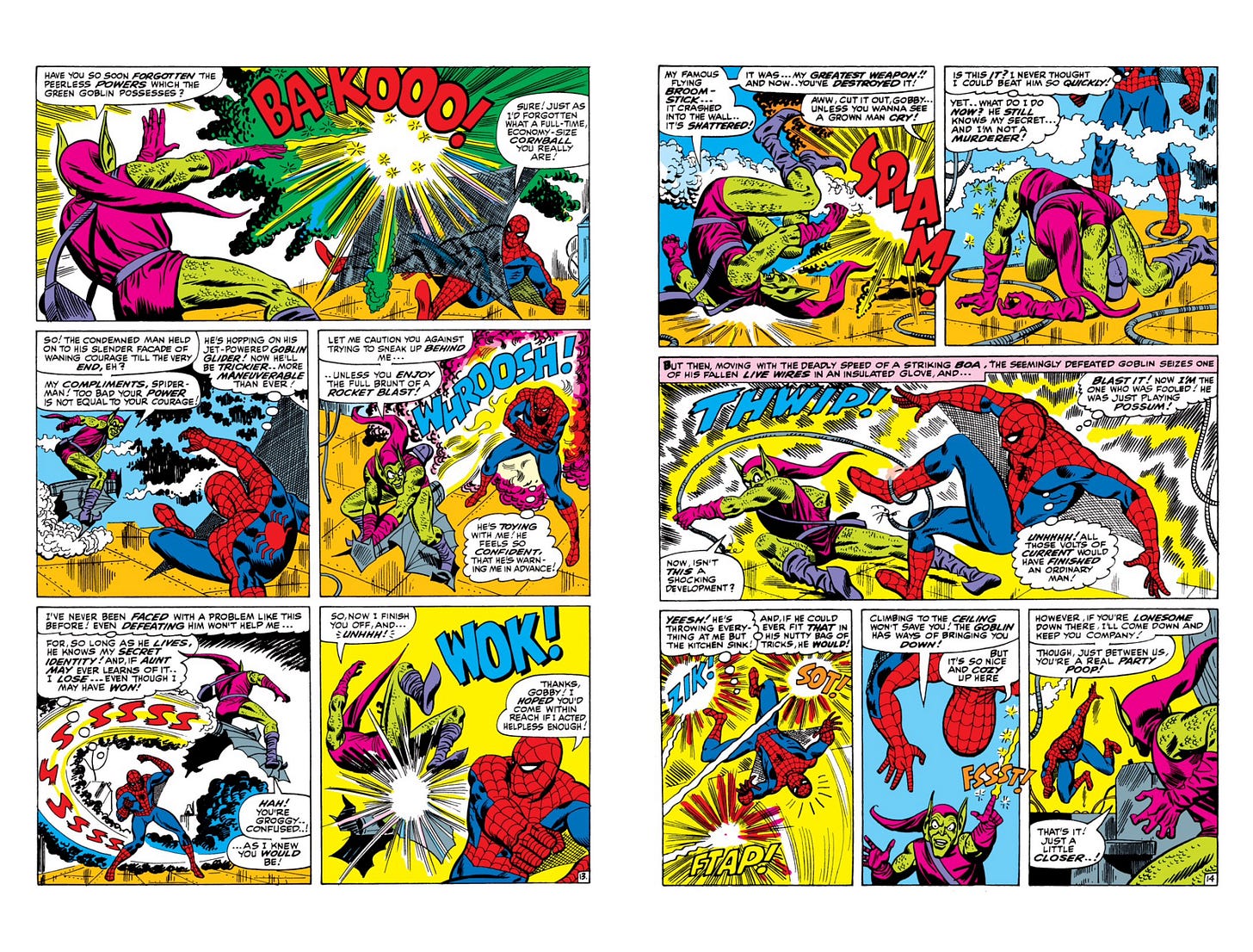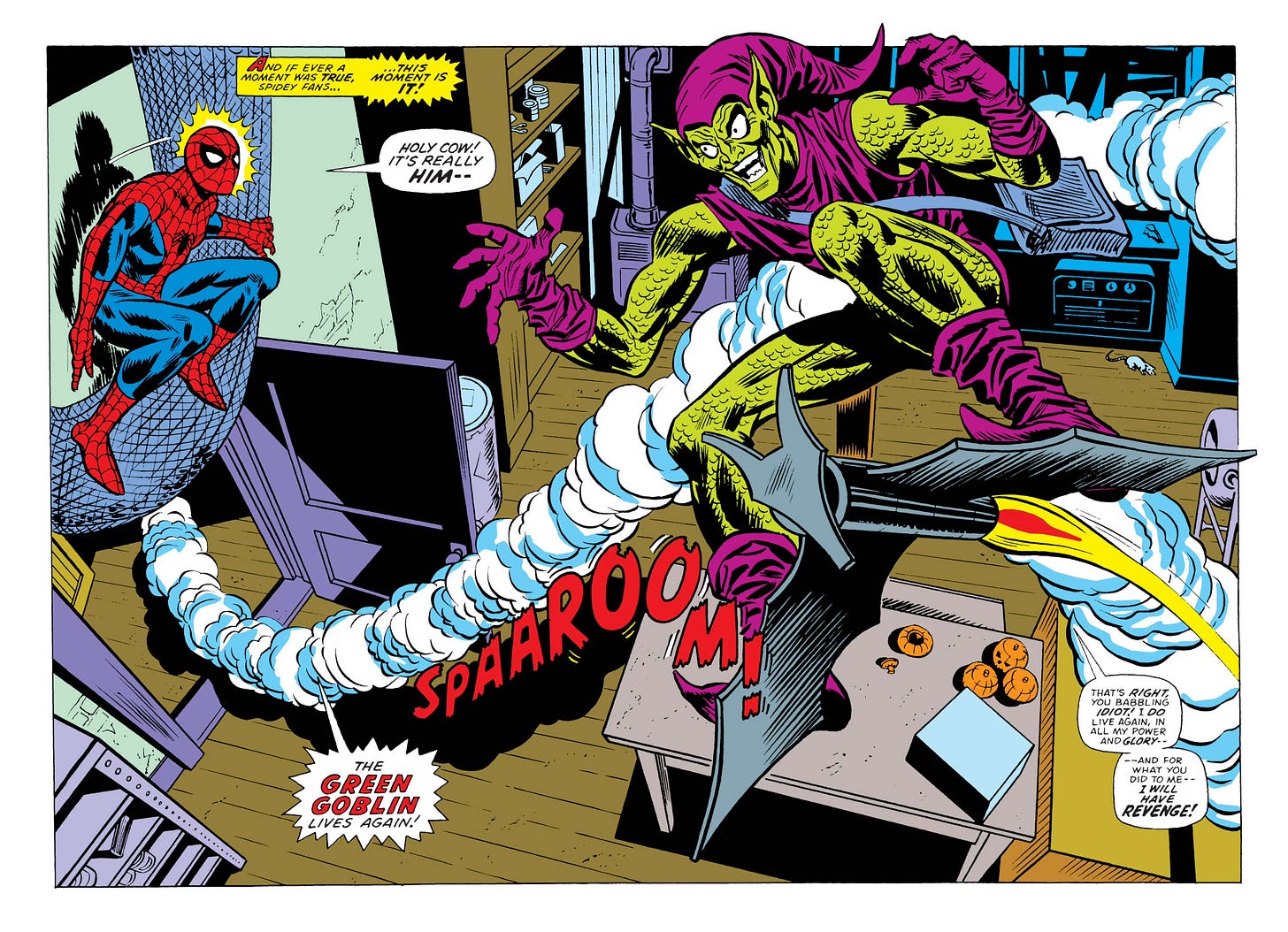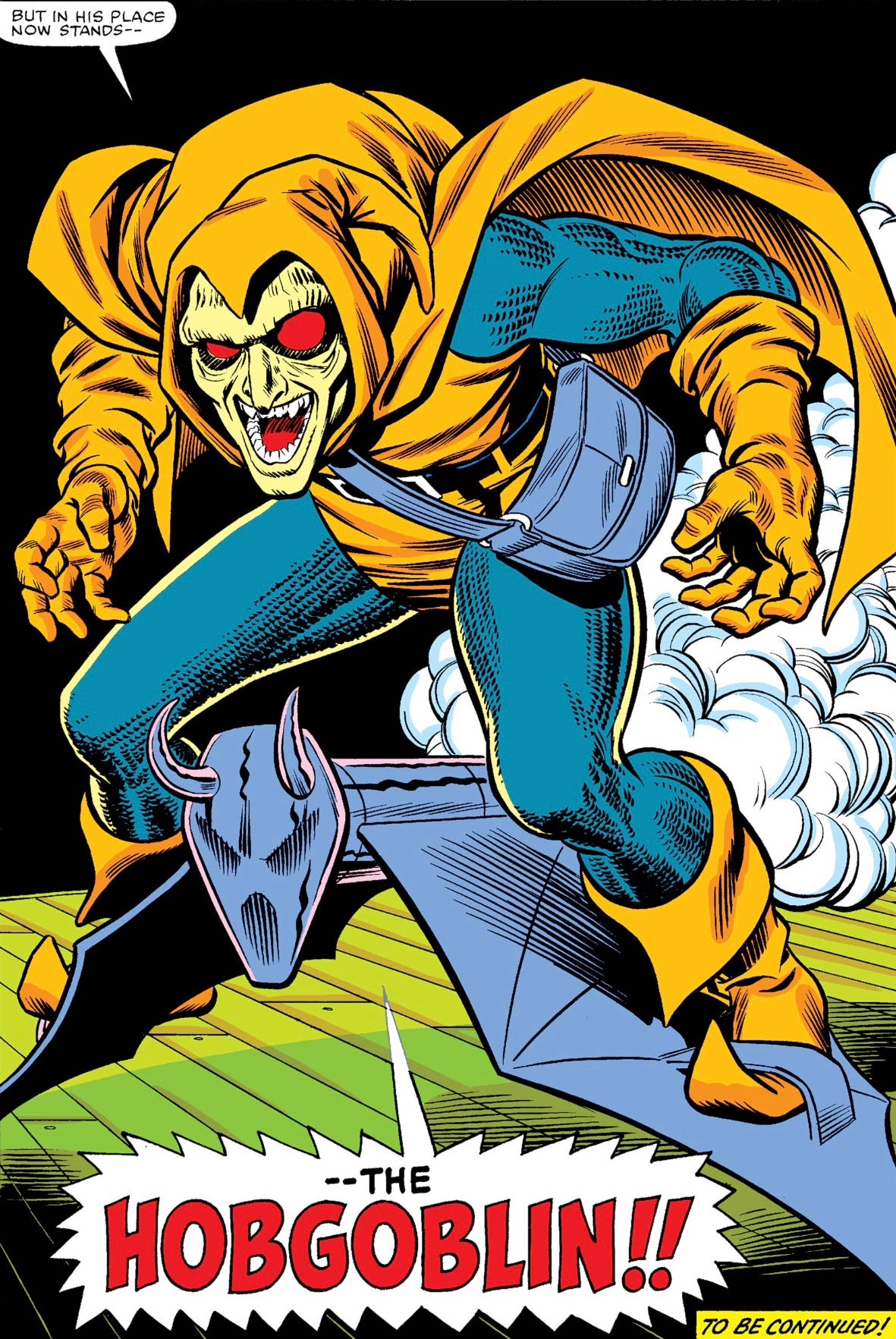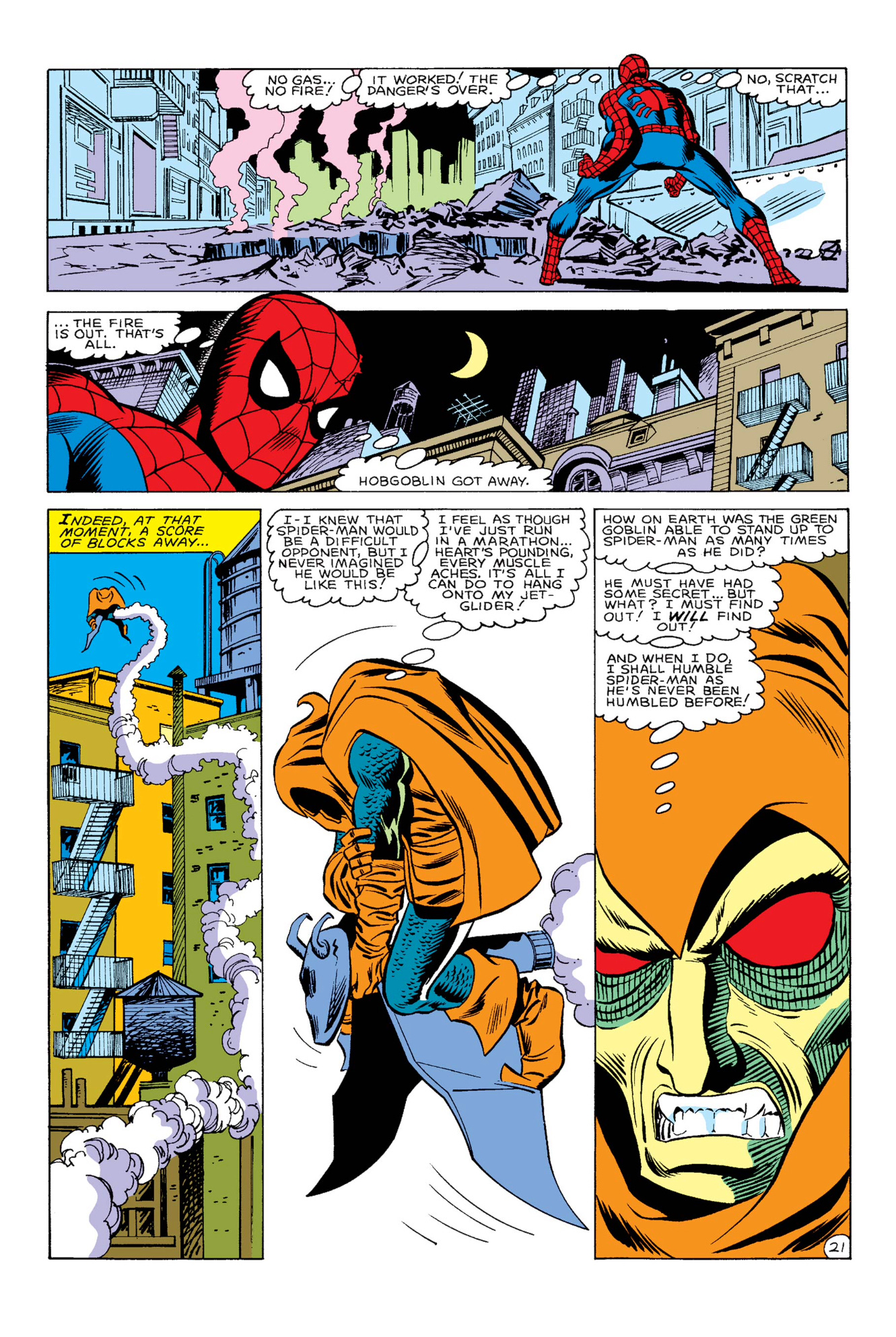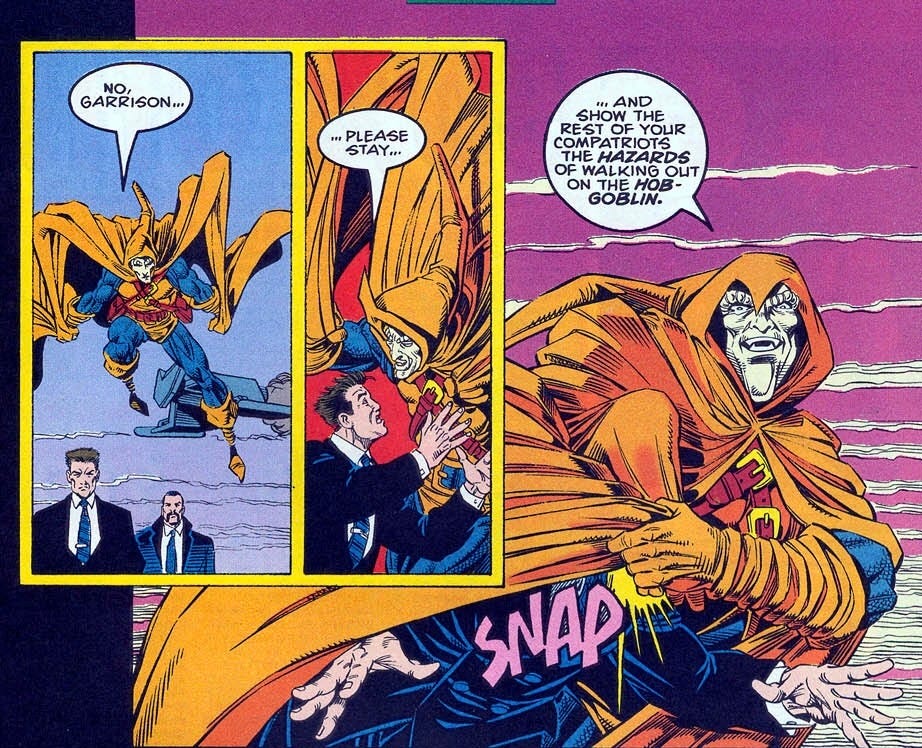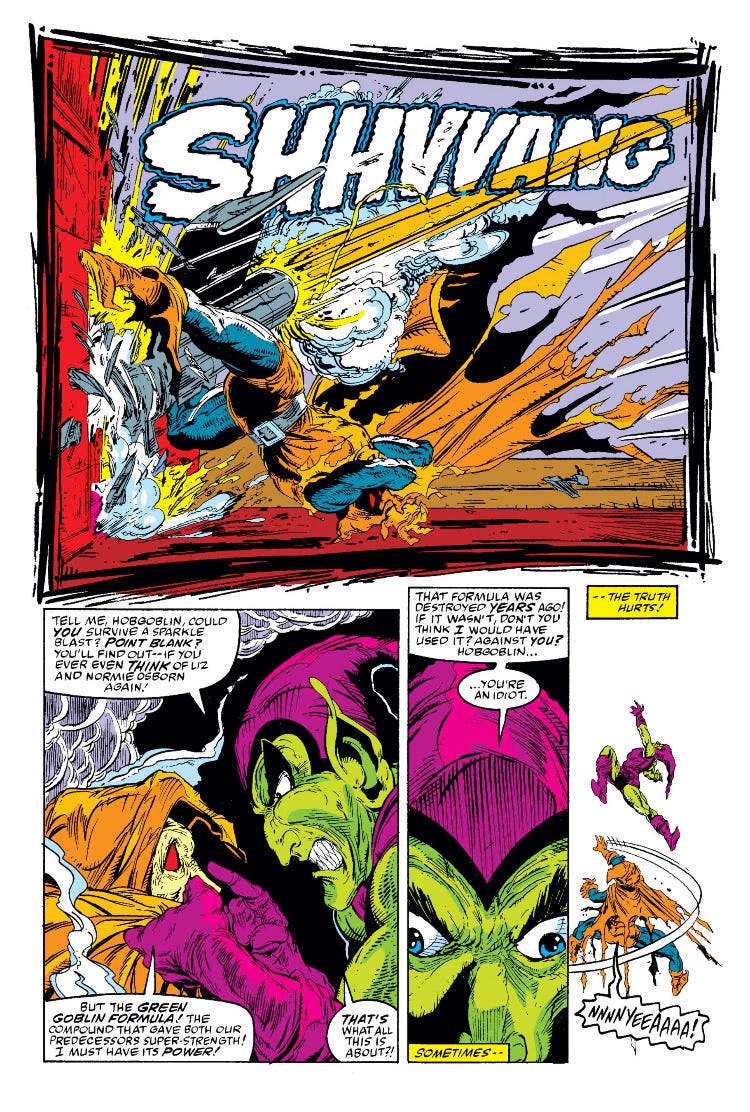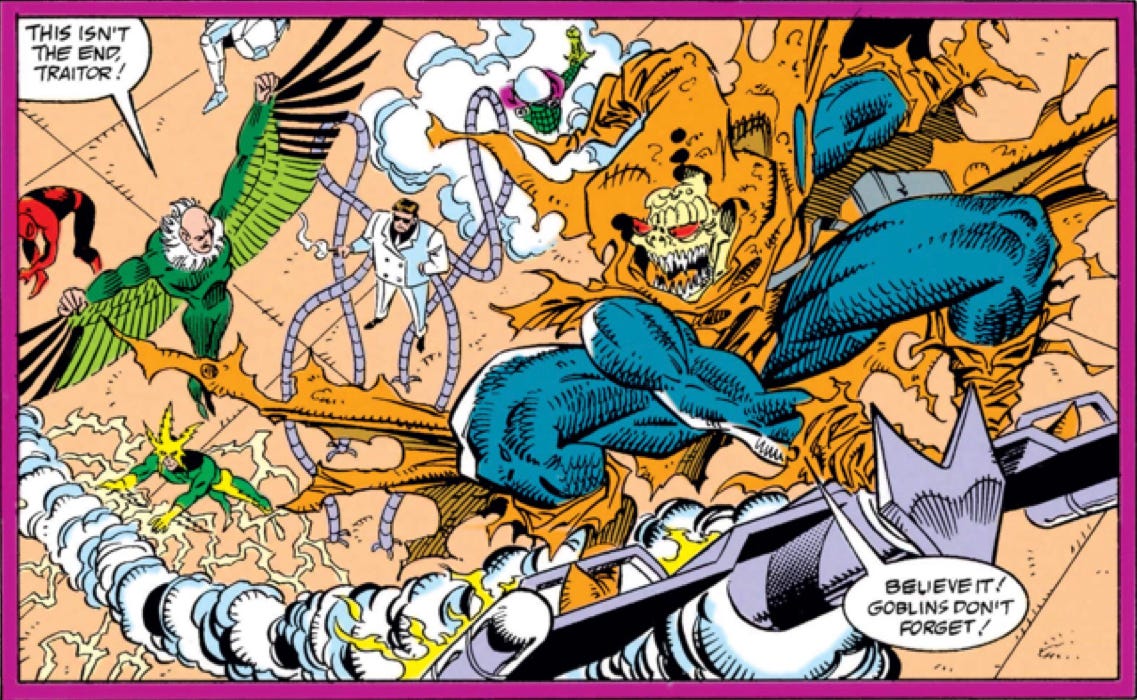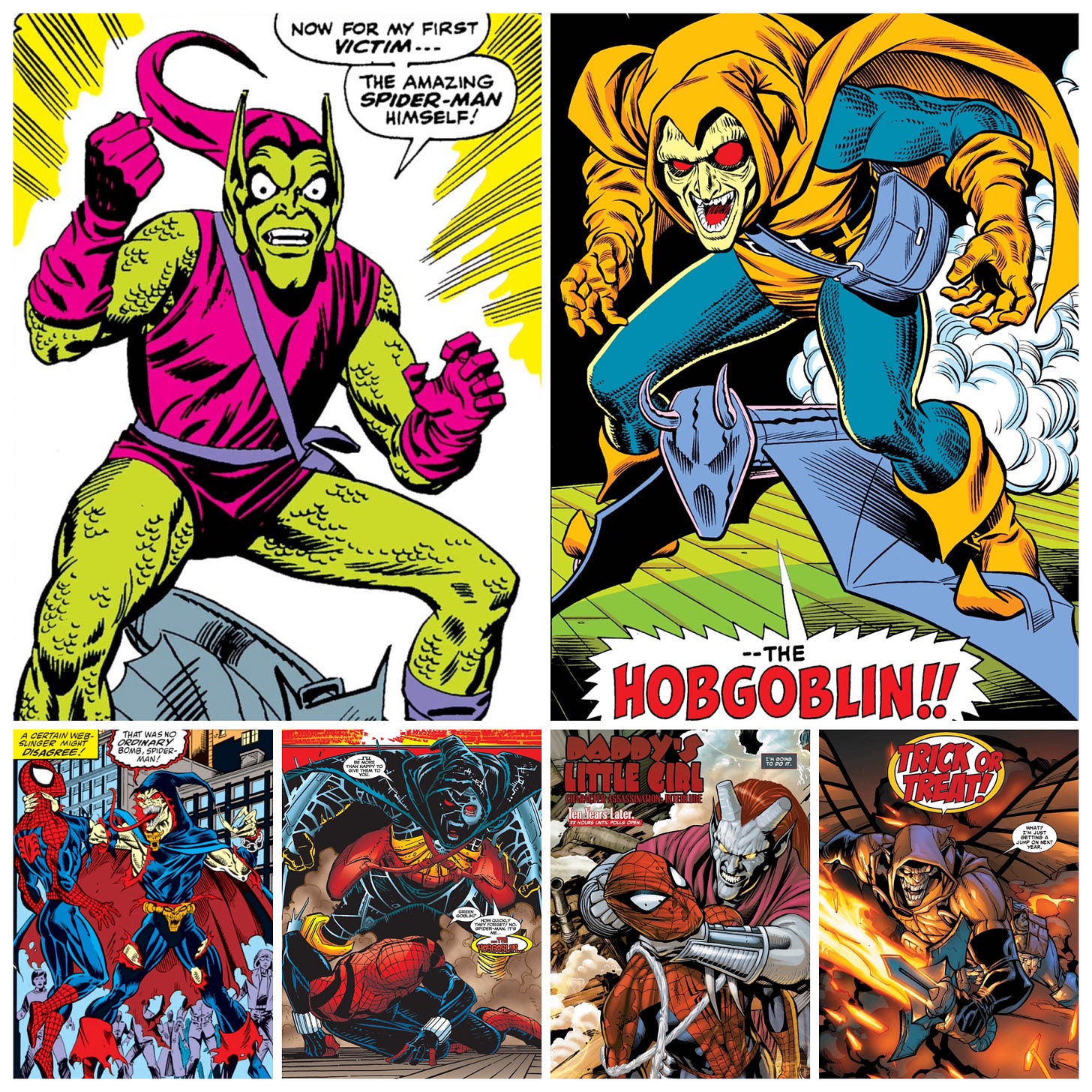
There are many rivalries in nature that have permeated the collective consciousness of humanity: cats and dogs, cobras and mongooses, sperm whales and giant squid, bats and clowns, etc., but no rivalry is as fierce as the one between spiders and goblins. There have been a plethora of goblin-themed villains that have haunted Spider-Man over the years, and it can be easy to get confused as to which is which. Fortunately, I’m here to alleviate that confusion!
Green Goblin (Norman Osborn)
When Stan Lee and Steve Ditko created the Green Goblin all the way back in Amazing Spider-Man #14, there’s no way either of them could have predicted the impact this Halloween-themed supervillain would have on Spider-Man comics for the decades to follow. In that initial appearance, it became clear pretty quickly that Stan Lee and Steve Ditko had something a little different planned for this villain. Typically when the duo would introduce a new villain to torment Spider-Man, they would provide a full origin story for the character that would make his identity and motivations clear. That wasn’t the case for the Green Goblin. His identity was intentionally withheld from the reader as he formulated a needlessly complex plan to get Spider-Man out of the way as he sought to establish himself as the top dog in the New York City crime scene. Needless to say, he did not succeed. Most of what we associate with the Green Goblin is in that initial appearance. He has the bright green costume with purple tunic and hat, he has his stylish purse, pumpkin bombs, razor bats, and he rides a flying mechanical contraption. The only real difference is that he rode a motorized broom instead of the goblin glider we’re familiar with today. He would eventually switch to the more recognizable glider a few issues later.
Green Goblin would pop up fairly frequently throughout the Stan Lee and Steve Ditko run. Each time he would manage to escape before he could be unmasked. It wasn’t until Amazing Spider-Man #39 that Green Goblin really elevated his status as Spider-Man’s arch-nemesis. In that issue (written by Stan Lee and drawn by John Romita, Sr.), the Goblin hits Spider-Man with a gas to dampen his spider sense and allow him to follow the hero without detection. He then becomes the first villain to learn that Spider-Man’s true identity is Peter Parker. After one of the more brutal fights between the two, Green Goblin captures Spider-Man and brings him back to his hideout where he reveals he is Norman Osborn. Osborn was a fairly minor character at this point and was known more for being the father of Harry Osborn, Peter’s college friend. Norman reveals his origin story to Peter in a classic supervillain monologue that details how a chemical formula he was working on literally exploded in his face and imbued him with his super strength and invulnerability (and a newfound madness that he mistakes for mental fortitude). Spider-Man does what heroes always do in such situations and uses that time to get free. After one of the best fights the two have ever had, Green Goblin falls into some live wires that electrocute him and give him a case of amnesia. He seemingly has no memory of being the Goblin or who Spider-Man really is, so Spidey destroys his costume and hopes Norman will live the rest of his life without ever becoming the Green Goblin again. Spoiler alert: Spider-Man isn’t that lucky.
As the Silver Age ‘60s gave way to the Bronze Age ‘70s, comics began to tackle more serious topics. A recurring plot point in Amazing Spider-Man during this time was Harry Osborn dealing with drug addiction. Harry’s issues began to translate into Norman’s issues. He would periodically revert back into his Green Goblin persona, regain all of his memories, fight Spider-Man, and then revert back to his Norman state and forget what had happened. This period clearly serves as inspiration for Willem Dafoe’s big screen portrayal of the character. This routine came to an end in Amazing Spider-Man #121 from Gerry Conway and Gil Kane. This time the Green Goblin returns and decides to abduct Peter Parker’s love interest at the time, Gwen Stacy. After a fight with Spider-Man atop the George Washington Bridge, Goblin flings Gwen off the bridge to her death with Spider-Man devastated at his failure. An enraged Spider-Man fights Green Goblin one more time with the intent to kill him for what he has done. With Norman on the ropes after being beaten to a pulp, Spider-Man decides to show mercy and not give in to revenge. Goblin being the absolute worst decides to try to stab Spider-Man in the back with his remote controlled goblin glider, but Spider-Man dodges it as it plunged into Norman’s chest and kills him. Thus concludes the story of the Green Goblin (lol not really).
Green Goblin (Harry Osborn)
Norman Osborn was killed in Amazing Spider-Man #122, so Spider-Man was able to enjoy a Goblin-free life for exactly fourteen issues. That’s when his good buddy Harry Osborn decided to take up his father’s legacy and don the Green Goblin costume. Harry’s villainous turn was chalked up to failing mental health as a result of his drug abuse and a series of personal tragedies and stressful events. His master plan to get revenge on Spider-Man for the “murder” of his father is to kidnap Flash Thompson, Mary Jane, and Aunt May, stash them in different warehouses, and strap a small nuclear bomb to one of them and fakes to the other two. Spider-Man would then have to choose which one to save and hope he picks the one with the real nuclear bomb. Spider-Man chooses Aunt May, and he lucks out because that was where the real bomb was. You read that correctly. Harry Osborn was going to nuke Aunt May. The actual fight that ensues at Harry’s apartment between Peter and Harry can barely be considered a fight. Unlike Norman, Harry never had access to the formula that gave him super strength and invulnerability. Spider-Man dispatches him almost immediately, and he removes the Green Goblin costume to protect his identity before police arrive responding to a noise complaint from Harry’s neighbors. Harry declares that Peter is Spider-Man and that he is the Green Goblin. The officers assume he’s just having a mental breakdown, and Harry is taken away to a mental hospital for help. Finally Spider-Man would be done dealing with the Green Goblin…for about forty issues.
Green Goblin (Bart Hamilton)

That’s right, folks! There is yet another character to take up the Green Goblin mantle in Amazing Spider-Man #176 from Len Wein and Ross Andru. The background here is pretty bonkers. Harry had been being treated for his long list of mental issues by a psychiatrist named Dr. Bart Hamilton. Using hypnotherapy, Hamilton learns that Harry had been telling the truth about being the Green Goblin. With this knowledge, Dr. Hamilton does what any good psychiatrist would do: he decides to become the Green Goblin himself and become New York City’s new crime lord. There isn’t a whole lot to say about this iteration of Green Goblin. He torments Spider-Man for one story arc before Harry Osborn puts on his own Green Goblin costume to take down this new one.
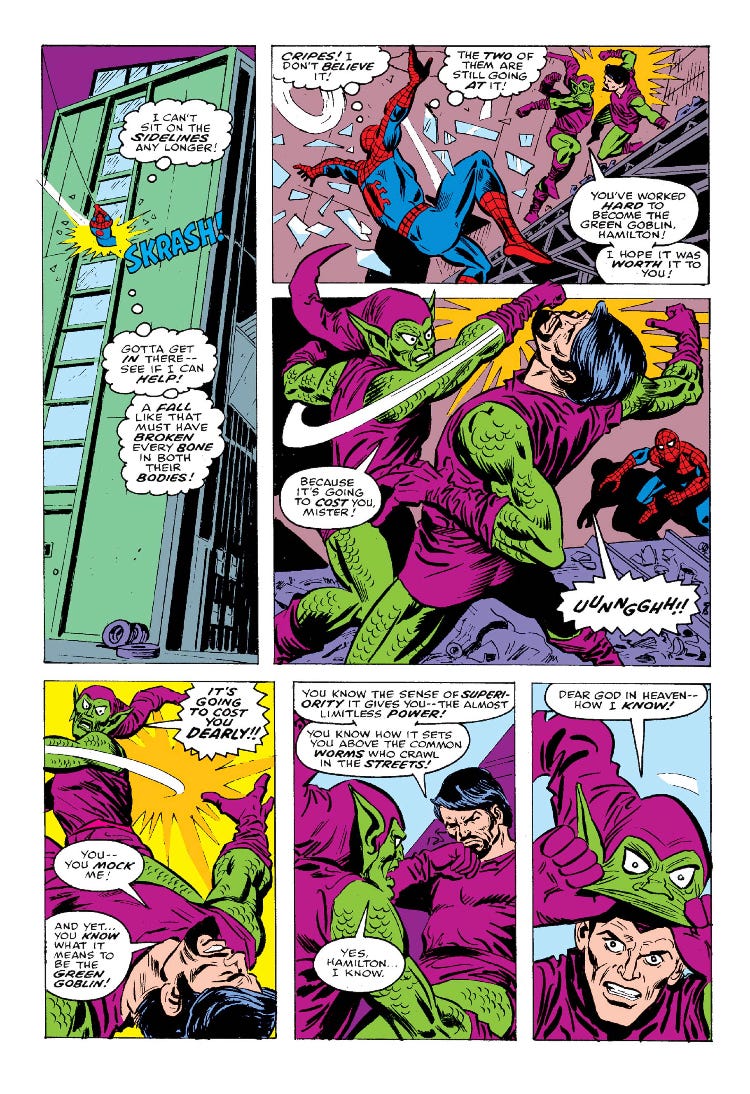
Hamilton dies in an explosion, and he’s barely ever referenced in another comic book after that. I think that’s probably for the best.
Hobgoblin (Roderick Kingsley)
After the death of Bart Hamilton, we didn’t see a new Green Goblin pop up for quite some time. That isn’t a smart ass comment from me this time. Harry went back to being a supporting character for Spider-Man, and Norman and Bart stayed dead. Nearly sixty issues of Amazing Spider-Man were published without nary a Goblin (to say nothing about the sister title Spectacular Spider-Man which had never had a Goblin grace its pages up to this point). Roger Stern was the writer of Amazing Spider-Man at this time, and John Romita, Jr. had followed in his father’s footsteps as the penciler on the book. Stern’s run was successful, but he was getting pressure from fans and editorial to bring back more classic villains for Spider-Man to fight. Enter: the Hobgoblin. Hobgoblin went back to the roots of the original Green Goblin by making his identity a mystery to both Spider-Man and the readers. Hobgoblin’s origin is laid out in Amazing Spider-Man #238 in which a low level criminal accidentally stumbles upon one of Norman Osborn’s secret warehouses of Goblin gear that he had apparently stashed throughout the city. Not only that, but one of Norman’s journals was there as well. At this point in the comics, the general public did not know Norman was the original Green Goblin. Now with this journal, whoever possessed it would not only know his identity but also specs and blueprints for all of his weapons. The criminal who found everything told his mysterious employer who promptly stole all of the tech, made alterations to the costumes, and killed the man who showed him everything to make sure no one else would find it. At that moment this mysterious figure would become the Hobgoblin. His altered costume is a great one as designed by John Romita, Jr. Hobgoblin abandons the pointy hat and replaces it with an orange cloak. He also alters the mask to be more of a pale sickly appearance in lieu of the bright green of his predecessor. The following issue sees Hobgoblin try his luck at taking down Spider-Man. It does not go well. Hobgoblin manages to escape before he can be unmasked, but his pride is badly wounded. There is a genuinely hilarious page that follows where he bemoans the fact that Spider-Man whooped his ass so thoroughly and wonders how Norman had been able to go toe-to-toe with Spider-Man so many times.
Unlike the ways Harry and Bart went about solving their arachnid problems, Hobgoblin immediately sets out to find a way to give himself super strength and invulnerability to be able to fight Spider-Man. In Spectacular Spider-Man #85 from Bill Mantlo and Al Milgrom, he does exactly that by pouring over Norman’s journals and developing a formula that would give him similar abilities but without the madness. From this point forward Hobgoblin is entrenched as a top tier Spider-Man villain. He would terrorize Spider-Man throughout the ‘80s not because of some personal vendetta but because he is obsessed with expanding and consolidating wealth and power. Every decision he makes is shrewd in the sense of trying to minimize risk while maximizing profit. He’s basically a criminal CEO (redundant, I know). One of the things he was extremely successful at was constantly throwing red herrings at Spider-Man and the police with regards to his identity. He would frequently put his underlings in Goblin attire to take the fall for his crimes. He would even kidnap various characters and dress them in his costume to be caught by police (Flash Thompson suffered such a fate). Most famously he kidnapped and brainwashed Ned Leeds into believing he was the real Hobgoblin. When Leeds was later murdered, mercenary and sometimes ally Jack O’Lantern would usurp the identity of Hobgoblin while the true Hobgoblin would lay low and bide time until he would strike again. There is a long and sordid history of who Hobgoblin was supposed to be during this time, but the basics are such: Roderick Kingsley, the ruthless fashion mogul, was who Roger Stern intended to be Hobgoblin, but he left the book before he could reveal it. Tom DeFalco took over the book but didn’t like Stern’s planned reveal. He decided to reveal the Hobgoblin as Richard Fisk, the son of the Kingpin. Unfortunately, DeFalco was fired off the book before he could unmask the character. Peter David ended up being the writer given the job of wrapping up the story, and he made Ned Leeds the Hobgoblin shortly before the character was killed off in a different book. What a mess. Stern himself would later retcon that Kingsley was always the original Hobgoblin along with artist Ron Frenz in a 1998 limited series titled Spider-Man: Hobgoblin Lives. Kingsley has been the canon original Hobgoblin ever since, just as his original creator intended.
Hobgoblin (Jason Macendale)
But for now there’s a new Hobgoblin in town! This one is mercenary Jason Macendale who was previously the supervillain Jack O’Lantern. Jack O’Lantern was essentially a Goblin in everything but name. He had a Halloween-themed costume (a flaming pumpkin head as a helmet), rode a rocket powered glider, and used pumpkin bombs as weapons.
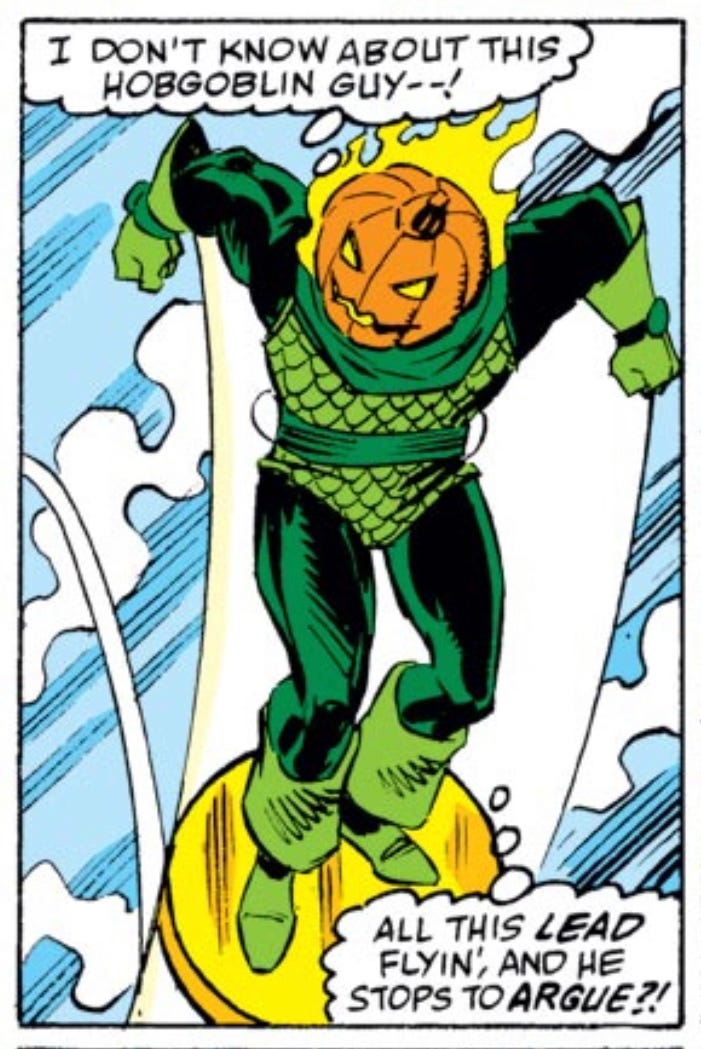
It’s no wonder he snatched up the Hobgoblin moniker as soon as the opportunity presented itself in Amazing Spider-Man #289 by Peter David, Alan Kupperberg, and Tom Morgan. Unlike Kingsley, Macendale had no super powers. Most of his early stories involved him searching for a way to gain super powers to be able to actually pose a threat to Spider-Man. How embarrassing for him. At one point he even goes after Harry Osborn to try and get him to hand over Norman Osborn’s original formula (something Harry didn’t even have). This coaxes Harry out of retirement as the Green Goblin temporarily, and we’re treated to the two Goblins doing battle as drawn by Todd McFarlane in Amazing Spider-Man #312 (written by David Michelinie).
Eventually Macendale finds a way to get super powers: willingly allowing himself to be possessed by a demon! What could possibly go wrong? This happens in the midst of the “Inferno” X-Men event when demons from Limbo had invaded New York City. This happens when he strikes a deal with the demon N’Astirh in Spectacular Spider-Man #147 by Gerry Conway and Sal Buscema. The only real benefit from this change is that he looks really cool when Erik Larsen draws him in subsequent issues as a member of the Sinister Six. Unfortunately for Macendale, the demon possessing him also thinks he’s a loser and splits into a separate identity by the name of Demogoblin!
Next week we’ll explore the most ‘90s of all Goblins.





